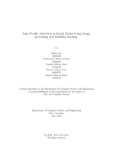| dc.contributor.advisor | Hossain, Muhammad Iqbal | |
| dc.contributor.advisor | Sakeef, Nazmus | |
| dc.contributor.author | Sen, Shuva | |
| dc.contributor.author | Islam, Mohammad Intisarul | |
| dc.contributor.author | Azim, Samiha Sofrana | |
| dc.contributor.author | Norin, Fatema Akhtar | |
| dc.contributor.author | Shuha, Samiha Tasnim | |
| dc.date.accessioned | 2021-09-14T05:58:18Z | |
| dc.date.available | 2021-09-14T05:58:18Z | |
| dc.date.copyright | 2021 | |
| dc.date.issued | 2021-06 | |
| dc.identifier.other | ID: 16101202 | |
| dc.identifier.other | ID: 16301145 | |
| dc.identifier.other | ID: 17101290 | |
| dc.identifier.other | ID: 16301172 | |
| dc.identifier.other | ID: 17201070 | |
| dc.identifier.uri | http://hdl.handle.net/10361/15002 | |
| dc.description | This thesis is submitted in partial fulfillment of the requirements for the degree of Bachelor of Science in Computer Science and Engineering, 2021. | en_US |
| dc.description | Cataloged from PDF version of thesis. | |
| dc.description | Includes bibliographical references (page 38). | |
| dc.description.abstract | Almost everybody has a social media presence in today’s technologically advanced
world. As a result, making fake accounts is very easy. The term ”fake profile”
refers to a person who may pretend to be someone else. These accounts are mostly
used to impersonate others and defame them. Furthermore, a fake account can
be used for various reasons, including igniting political feuds, spreading misleading
facts, and disseminating news about current sensitive topics. Since fake profiles
pose such a serious threat to everyone, a model was proposed that might aid in
the reduction of fake profiles. It can assist with identifying accounts that could be
accused of being fraudulent, such as those without a profile photo. To ensure that
each user has a unique profile, machine learning and image recognition was used in
our model. Our model attempted to discourage users from creating accounts using
the photo or knowledge of another person. To do this, One Time Password (OTP)
was implemented so that fake users can not get the chance to create an account
by using another person’s name. Fake accounts needed to identify by using deep
learning from a real dataset of people’s answers. To detect the false results, the
k-means algorithm was implemented on our dataset. When the k-means clustering
algorithm was used on the dataset, it was discovered that our detection accuracy
was 75.30 percent. | en_US |
| dc.description.statementofresponsibility | Shuva Sen | |
| dc.description.statementofresponsibility | Mohammad Intisarul Islam | |
| dc.description.statementofresponsibility | Samiha Sofrana Azim | |
| dc.description.statementofresponsibility | Fatema Akhtar Norin | |
| dc.description.statementofresponsibility | Samiha Tasnim Shuha | |
| dc.format.extent | 30 pages | |
| dc.language.iso | en | en_US |
| dc.publisher | Brac University | en_US |
| dc.rights | Brac University theses are protected by copyright. They may be viewed from this source for any purpose, but reproduction or distribution in any format is prohibited without written permission. | |
| dc.rights | Brac University theses are protected by copyright. They may be viewed from this source for any purpose, but reproduction or distribution in any format is prohibited without written permission. | |
| dc.subject | Fake profile | en_US |
| dc.subject | Machine Learning | en_US |
| dc.subject | image recognition | en_US |
| dc.subject | One Time Password | en_US |
| dc.subject | k-means | en_US |
| dc.subject | accuracy | en_US |
| dc.subject | fraud | en_US |
| dc.subject.lcsh | Machine Learning | |
| dc.title | Fake profile detection in social media using image processing and machine learning | en_US |
| dc.type | Thesis | en_US |
| dc.contributor.department | Department of Computer Science and Engineering, Brac University | |
| dc.description.degree | B. Computer Science | |

